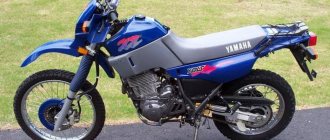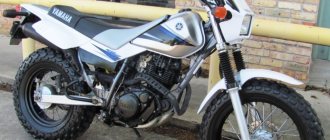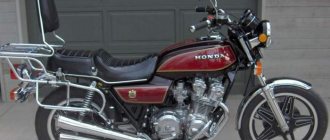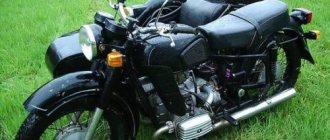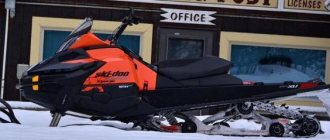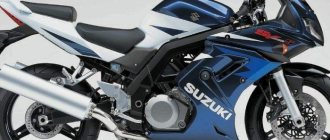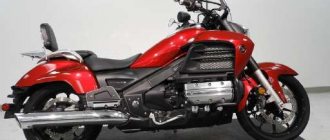Motorcycle of the Decade
The superbike that brought sports design to the forefront was released in 1987 under the name Yamaha FZR 1000. Then the car had a top speed of over 250 km/h, and the 1989 modification, called the motorcycle of the decade, could accelerate to 100 km/h in less than 3 s. Its maximum speed exceeded 270 km/h. With such characteristics, any bike would be in great demand, so production continued.
In 1989, the manufacturer improved the performance of the Yamaha FZR 1000 by increasing the engine displacement to 1002 cm3 and adding electronic exhaust valve control. The latter's shortened name, EXUP, became the motorcycle's well-known nickname. Despite the increase in engine displacement, it has become more compact and 8 mm shorter due to a change in the inclination of the cylinders to 35°. The angles and sizes of the valves have changed, as well as the timing of the camshaft. Larger carburetors helped improve performance, the crankshaft was strengthened, and countless other changes were made. The system was replenished with useful power at mid-range speeds, and the engine's horsepower increased to 145.
A unique feature that appeared on models beginning in 1989, known as EXUP, was a servo motor that controlled the exhaust valve. This made it possible to increase the diameter of the exhaust pipe for better fuel supply at high engine speeds, as well as limit it at low speeds. The chassis was also improved and the bike's handling improved, making the EXUP system popular with other Japanese superbikes.
The 1989 frame (now called Delta Box 2) used the engine as a stressed member. Gone are the downpipes, replaced by a secure mount of the cylinder head to the top of the frame. This design became the basis for the radical chassis layout of the YZF R1 almost 10 years later. For 1987, the 18-inch rear wheel was replaced by a 5.5x17-inch one, and the 17-inch front wheel was widened to 89 mm. The standard fork leg diameter has increased by 2 mm to 43 mm. Other changes were more subtle, but no less valuable: the front and rear axles and swingarm pivot bolt were increased in diameter and made hollow. This strengthened them and increased stability under the loads of sharp turns. The Pirelli MP7S tires specially designed for this model have been called the best ever installed on a motorcycle, and according to user reviews, there is no reason to disagree with this. The 1987 FZR was equipped with Japanese-made Dunlop rubber, which had less grip than an eraser and had about the same lifespan. Users who have tried tires from various manufacturers, radial and diagonal, have not found anything better than Pirelli, except for the fabulously expensive, GP-quality, English-made Dunlop D364. Owners warn that the motorcycle is very sensitive to tire wear and tends to stand on end if the rear tread is worn out by more than half.
But the improvements don't stop there. In 1991, the package was modified to include the Yamaha FZR 1000 RU, featuring steeper inverted forks. Final improvements were made in 1991 and 1994, and then in 1996 the FZR1000 was replaced by the YZF 1000 Thunder Ace.
Touring motorcycle Yamaha Tracer 900 GT 2021
Yamaha Tracer 900 GT 2019
But let's take things in order. Last year, Yamaha updated the FJ-09 sport tourer and renamed it the Tracer (which is what the model has been unofficially called since its introduction for the 2021 model year). Then came the GT package with hard cases, heated grips and cruise control.
Performance-wise, the Tracer 900 GT appears to be the ideal touring motorcycle, combining sport-touring functionality with modern ergonomics and design. For those who have long been looking for a motorcycle with an upright riding position in the tourenduro style, but did not need off-road features at all, the Yamaha Tracer GT is simply an ideal option, along with the Kawasaki Versys 1000, occupying the niche of a budget competitor for the more expensive MV Agusta Turismo Veloce, KTM Super Duke GT and Ducati Multistrada 950.
Engine
A lot has already been said about the three-cylinder in-line engine with which the Yamaha Tracer 900 is equipped, and it is deservedly appreciated. It's torquey, spins well, and sounds like it has a nest of giant hornets inside. If you haven't driven a 3 before, you probably think it's somewhere between a 2 and a 4. Not quite so: the three is almost the same as the four, almost the same torque, but a little more torquey at the bottom, and more bassy when compared within the same cubic capacity.
Yamaha Tracer 900 GT 2019
Even so, there are vibrations, especially up to 6000 rpm, which makes the small mirrors rather useless on the move. The box shifts very smoothly, and the quickshifter (up only) works flawlessly.
The response to the throttle can be changed between three modes: STD (standard, of course), A (aggressive) and B (soft). The names are certainly counter-intuitive, but you get used to them quickly. Mode A makes the engine quite sharp, and given that the in-line three is not very slow anyway, in this mode the motorcycle takes on a truly sporty and explosive character.
Touring motorcycle
My partner asked me to note in the article that for a sports tourist the Tracer has harsh suspensions that provide very controlled steering during aggressive driving, but for a quiet ride I would like it to be a little softer. Wind protection is minimal, so the wind blows quite noticeably at highway speeds. More cons? The dashboard is a bit small, and the remote controls are both complex and awkward. The trunks do not fit anything larger than a city backpack and a change of clothes. It sounds like we're nitpicking, but we're talking about the GT, right? And these points are important for a touring motorcycle.
Overall, the Yamaha Tracer GT is the benchmark Yamaha in every way. Every aspect of the ride is impeccably precise - throttle, shifting, steering. It is controlled literally by the power of thought, and at the same time it does not feel like a roll or loose. Add to this a 24-degree headset, a fairly short wheelbase, a rigid aluminum frame and tight suspension - and you will understand how close the Tracer GT is to the Yamaha R-s.
While we were getting ready for the trip and our photographer was taking photos on the road, we were discussing the Yamaha Tracer GT. And we came to the conclusion that this is a good motorcycle, very correct, but it is neither this nor that. It's not as exciting as a sportbike or naked bike (on which it's broadly based), and its edgy nature isn't exactly conducive to relaxed touring. Objectively, the Tracer GT is a great bike, but its hypernaked sharpness feels strange and even harsh in a touring bike form factor.
First 4-stroke
The Yamaha FZR-1000 Genesis is a significant model that marked the transition from 2-stroke to 4-stroke sports motorcycles. This change gave rise to a new generation of high-performance big bikes that incorporated racing technology. The first Genesis was unveiled to the public at the IFMA motorcycle show in Cologne (Germany) on September 18, 1986 and continued the success of its predecessors, the RD 350 and RD 500.
Yamaha GTS 1000 price based on sales advertisements
The maximum price of Yamaha GTS 1000 among the advertisements found is RUB 900,000*
The average price of Yamaha GTS 1000 among the ads found is RUB 186,000*
The minimum price of Yamaha GTS 1000 among the advertisements found is 6,000 rubles*
Selling Yamaha GTS 1000 in Taldom
11/20/2020 185,000 rub.
Yamaha GTS 1000 in Smolensk
11/16/2020 185,000 rub.
Yamaha gts 1000 in Shakhovskaya
09.09.2020 120,000 rub.
Yamaha GTS 1000A in Moscow
02/14/2020 155,000 rub.
Selling a Yamaha GtS 1000 sport-tourist motorcycle in Abakan
09/14/2019 140,000 rub.
Yamaha GTS1000 in Solnechnogorsk
07/23/2019 155,000 rub.
Yamaha GTS 1000 in Mytishchi
07/18/2019 178,000 rub.
Yamaha GTS 1000 motorcycle in Zelenokumsk
06/17/2019 220,000 rub.
Yamaha GTS1000 4BH-001163 1997 in Vladivostok
06/17/2019 169,000 rub.
Yamaha GTS 1000 with a unique front fork in Livny
06/13/2019 RUB 269,999
Yamaha GTS1000A in Naberezhnye Chelny
06/11/2019 149,000 rub.
Yamaha gts 1000 in Palekh
09/04/2017 160,000 rub.
Yamaha gts 1000 in Moscow
08/21/2017 155,000 rub.
Yamaha GTS1000 MCW Edition in Samara
02.08.2017 900,000 rub.
Yamaha GTS 1000 for sale in Livny
07/03/2017 250,000 rub.
Selling Yamaha GTS 1000 1993 in Voronezh
03/07/2017 250,000 rub.
Selling Yamaha GTS 1000 ABS 1993 in Orel
02/28/2017 250,000 rub.
Yamaha GTS 1000 Yamaha GTS 1000 in Moscow
02/03/2017 175,000 rub.
Yamaha GTS 1000 trike in Yelabuga
01/20/2017 85,000 rub.
Yamaha GTS 1000 A in Maykop
11/23/2016 200,000 rub.
Yamaha GTS 1000 abs in Moscow
11/16/2016 200,000 rub.
Yamaha GTS 1000 in Moscow
11/16/2016 200,000 rub.
Yamaha GTS 1000 in Chelyabinsk
08/19/2014 150,000 rub.
Yamaha GTS1000 1997 in Vladivostok
08/05/2014 150,000 rub.
Yamaha GTS1000 in Moscow
08/01/2014 150,000 rub.
Complete set of engine gaskets for Yamaha GTS1000 in Obninsk
06/25/2014 6,500 rub.
Steering gear Yamaha GTS1000 in Obninsk
06/25/2014 7,000 rub.
Steering knuckle for Yamaha GTS1000 in Obninsk
06/25/2014 12,000 rub.
* Attention! Under the maximum, average and minimum of the Yamaha GTS 1000 motorcycle on this page, the average cost according to advertisements for sale on the Internet is indicated, without taking into account the year of manufacture, configuration and generation of the motorcycle model.
Exterior
In 1989, Yamaha redesigned its largest sports bike, and it was completely transformed. The new sportbike felt smaller, lighter and lower, but the radical improvements showed up in the ride. The motorcycle seat has been redesigned and has become wider, more ergonomic and more comfortable.
In the opinion of many, the Yamaha FZR 1000, which appeared in 1987, was the best available model with an engine displacement of 1000 cm3. There were no major changes to the exterior design, with the exception of a headlight change in 1991 and 1992 and the addition of a 4-piston brake caliper in 1989. The air intake system was improved for the 1991 and 1992 versions. During the final years of production, the FZR was reverted to the original model's dual headlight design, which was retained until production ended in 1996.
Victor Kryukov
AES-MOTO Technical Specialist
On the dyno, the YZF-R1M produced 191 horsepower. With. (on the shaft) - it is clearly visible that Yamaha did not rely on maximum engine power. Everything is quite standard and uninteresting: a torque model for controlling the electric damper, a high compression ratio - almost everything is inherited from the YZF-R1 of previous modifications. Observing trends in technology development, we can confidently say that engine building has reached a certain dead end, having reached a power of 200 hp. With. from “liter” on serial equipment. The YZF-R1M focuses on electronics. The algorithms of the internal combustion engine control unit remained unchanged. But all systems have been transferred to ARM processors, and the old proven real-time code has been replaced by an operating system of Yamaha’s own production (possibly variations on the theme of Linux or Android). The transition to new software made it possible to implement modern traction and wheelie control algorithms, previously available only in sports control units - such as Motec or Marelli. Another interesting feature was the introduction of the 802.11B wireless interface into the motorcycle, better known in the wider community as Wi-Fi. Via a radio channel using the proprietary YRC Set-Up & DAC utility, at a fairly decent distance from the motorcycle, you can change the configuration of the electric throttle, control mechanisms, traction control and receive feedback in the form of a data stream from on-board sensors. Combine a radio channel with a CAN bus? On the one hand, this is a rather interesting function that gives the “advanced user” the ability to record and subsequently analyze data. On the other hand, in “computer” language, this is a clear Backdoor, and there is every chance that, having thoroughly understood the communication protocols with a motorcycle, in the hands of a competent “information security specialist”, the YZF-R1M can become a radio-controlled toy riding on the track .
Tags
Yamaha
Characteristics of Yamaha FZR 1000 Genesis
The power source of the motorcycle is a 989 cc water-cooled engine. cm. It had forward inclined cylinders and DOHC. The 20-valve format was introduced in the FZ750 two years earlier. The engine developed 130 hp. With. at a rotation speed of 10,000 rpm, but in 1989 the manufacturer increased the engine displacement to 1002 cm3, while the unit reached a power of 145 hp. With. at 10,000 rpm. He gave the name to the new modification EXUP. The system, first used on 4-stroke engines, increased performance and torque. The Power Limit Exhaust Valve is an exhaust gas control system that is still used on the YZF R1 today in an improved form. It allows you to regulate the flow of exhaust gases depending on engine speed.
Reviews
Reviews about Yamaha YZF1000R Thunderace:
Expand Collapse
What a great sports tour! Very powerful, with its 142 fillies it accelerates very easily. 100km/h in 1st gear? No problem! The abundance of plastic makes you think about its repair. I had a chance to ride this one a little 3-4 years ago. At first, my rear wheel often skidded. I decided to shoot in a straight line once and was surprised that I couldn’t accelerate more than 140-150, although there was a feeling of enormous speed. It turned out that it was an “American”, i.e. The speedometer was digitized in miles.
Very powerful and very flexible sport-tourer. Large, comfortable, heavy.
Of the minuses I would write:
- most likely it will consume oil (it is for these Yamaha engines that they are nicknamed oil guzzlers)
— A 5-valve circuit requires frequent valve clearance monitoring or there will be no compression
I took an ace in the fall, drove about 1000 km until the cold weather and so far only positive emotions. It drives very well from the bottom, which is good in traffic jams, it also handles perfectly. The speedometer was driving 280 km/h, there was even a reserve and it picks up this speed quickly and confidently .By the way, I didn’t add oil, I kept an eye on the level after every trip. They say that the oil gluttony also depends on what kind of oil you use. The plastic is well cut, doesn’t make it look bad anywhere, the suspensions are excellent. In short, you can ride on it for long distances, and you can fire it up like on a sports car
It drives very well from the bottom, which is good in traffic jams, it also handles perfectly. The speedometer was driving 280 km/h, there was even a reserve and it picks up this speed quickly and confidently .By the way, I didn’t add oil, I kept an eye on the level after every trip. They say that the oil gluttony also depends on what kind of oil you use. The plastic is well cut, doesn’t make it look bad anywhere, the suspensions are excellent. In short, you can ride on it for long distances, and you can fire it up like on a sports car
An intermediate model between the FZR1000 and R1, it was conceived as a sportbike. It turns out that it’s not a “tourist”, but according to reviews it’s good for long-distance driving)))
I was also interested in this model when I wanted to buy a bike. I read a lot of reviews about it, and they are all mostly positive.
What I liked about the ACE and what I still like is its versatility, it can go long distance and kick the ass of P1 fans on the Ring. And I also respect him, yes, I really respect him, because in 3 years there has never been a time when I inserted the key into it and drove away from the parking lot in a car. I haven’t even removed the battery from it once in 3 years, neither in winter nor in summer, I wanted to go for a ride, key to start and go, in a word, I respect reliable equipment. I have driven quite a bit on it, almost 20,000 km, so I can speak for it. I won’t talk about how lucky a liter is…
Specifications
The technical specifications of the Yamaha FZR 1000 are as follows:
- engine displacement: 1002 cm3;
- engine type: in-line 4-cylinder;
- number of cycles: 4;
- power: 145 l. With. (105.8 kW) at 10 thousand rpm;
- number of valves per cylinder: 5;
- starter: electric;
- transmission: 5-speed;
- weight without fuel: 214 kg;
- seat height: 775 mm;
- front brakes: double disc;
- rear brakes: single disc;
- power to weight ratio: 0.6776 hp. s./kg
- acceleration to 100 km/h: 2.9 s;
- Max. speed: 275 km/h.
Specifications
Comparative table of technical characteristics of the 1st and 2nd generations of Yamaha FZ-1:
| Model | Yamaha FZ1, FZS1000 Fazer (2001-2005) | Yamaha FZ1-N, FZ1-S Fazer (2006-2015) |
| Motorcycle type | naked | |
| Frame | steel | aluminum diagonal |
| engine's type | 4-cylinder, 4-stroke, in-line | |
| Working volume | 998 cm³ | |
| Bore/Stroke | 74.0 x 58.0 mm | 77.0 x 53.6 mm |
| Compression ratio | 11,4:1 | 11,5:1 |
| Cooling | liquid | |
| Number of valves per cylinder | DOHC, 5 valves per cylinder | |
| Fuel supply system | carburetors, 4x Mikuni BSR37 with throttle position sensor (TPS) | injector, 45 mm |
| Ignition type | digital transistor (TCI) | digital transistor (TCI) with 32-bit ECU |
| Maximum power | 143 hp at 10000 rpm | 150 hp at 11000 rpm |
| Maximum torque | 106 Nm at 7500 rpm | 106 Nm at 8000 rpm |
| Clutch | Multi-disc in oil bath, cable drive | |
| Transmission | 6-speed | |
| type of drive | chain | |
| Front tire size | 120/70 ZR17M/C (58W) | |
| Rear tire size | 180/55 ZR17M/C (73W) | 190/50 ZR17M/C (73W) |
| Front brakes | 2 discs, 298 mm, 4-piston calipers | 2 discs, 320 mm, 4-piston calipers (optional ABS) |
| Rear brakes | 1 disc, 267 mm, 2-piston caliper | 1 disc, 245 mm, 1-piston caliper (optional ABS) |
| Front suspension | telescopic fork 43 mm (all adjustments), travel – 140 mm | inverted fork 43 mm (all adjustments), travel – 130 mm |
| Rear suspension | pendulum with monoshock absorber (all adjustments), stroke – 135 mm | pendulum with monoshock absorber (all adjustments), stroke – 130 mm |
| Overall dimensions (LxWxH) | 2125 x 765 x 1190 mm | 2140 x 770 x 1205 mm – FZ1-S 2140 x 770 x 1060 mm – FZ1-N |
| Seat height | 820 mm | 815 mm |
| Wheelbase | 1450 mm | 1460 mm |
| Minimum ground clearance (clearance) | 140 mm | 135 mm |
| Gas tank capacity | 21 l (including reserve – 4 l) | 18 l (including reserve - 3.4 l) |
| Maximum speed | 260 km/h | 246 km/h (N version) |
| Acceleration to 100 km/h | 2,9 | 3.3 sec |
| Motorcycle weight (dry) | 208 kg | 198 kg – FZ1-N 204 kg – FZ1-S |
| Motorcycle weight (curb) | 231 kg | 214 kg – FZ1-N 220 kg – FZ1-S |
Performance evaluation
The Yamaha FZR 1000 superbike is described by owner reviews as perfectly balanced and with enormous power. The chassis is quite capable of remaining stable under full engine load, making for a more enjoyable ride. According to user reviews, what they like most about it is its extremely light weight and maneuverability. The 45-degree cylinders and relatively low seat height make the bike feel lighter than the new R1, despite being 23kg heavier. The machine is very easy to handle and has extremely satisfactory acceleration. The FZR-1000 rider becomes one with the motorcycle for an unforgettable riding experience. On other modern sports superbikes you can only sit astride, and this is not so comfortable. But what moves fast needs to be stopped just as quickly, and the FZR-1000 has no problem with that. A durable motorcycle braking system will do the job reliably every time. The engine starts screaming when reaching 7000 rpm, and no moving objects on the road can overtake it at full power. Yamaha's 20-valve inline-4 engine is one of the most reliable engines ever made, so you can hit the road with confidence.
Ruben Xaus & YZF-R1M
Yamaha has finally created a worthy competitor to the BMW S1000RR, Ducati Panigale 1299 and Aprilia RSV4 Factory. In fact, it is no longer possible to draw analogies between the predecessor and the new model: they are completely different and are separated from each other by a whole generation. Probably, today the YZF-R1M is the most advanced production motorcycle in terms of electronics, which even provides the ability to control lateral slips.
To be honest, it can take quite a long time to understand the many settings that the engineers generously rewarded the new product with. For me personally, it’s most convenient when all electronic assistants are turned off. Of course, this does not mean that the electronics are not working correctly. I found engine response smoother and more predictable in the lower and mid-range than the BMW S1000RR and RSV4 Factory.
True, compared to the Ducati Panigale1299, the low and medium speed zone is not so pronounced. As for the output of the power unit in extreme conditions, I believe that here the YZF-R1M is quite comparable with its Italian and German counterparts. Of course, there are also points that I would like to change a little: let’s say, after the fourth lap at MRW and the second in Belgorod, the brakes were a little tired.
It should be noted that, unlike large tracks, on a karting track there is no place for the brake discs to be cooled by oncoming air at three-digit speedometer values, which is why on short tracks or karting tracks any problem with a motorcycle with braking systems is revealed much faster.
In terms of handling, the YZF-R1M is noticeably more interesting than the BMW S1000RR, it is lighter on the switchbacks, faster in chicanes, and sometimes gives the feeling of a 600 cc sports bike rather than a heavy “liter”. I think that Yamaha managed to bring a serious competitor to the market, and now the positions of the BMW S1000RR, just a trio of “Japanese”, as well as the Aprilia RSV4 Factory, will no longer be so strong and cloudless.
Price
Owners of motorcycles of this model take very good care of them, so it will not be difficult to find a copy that will look and ride great. If the owner has a complete service history for the car and the mileage seems satisfactory, then it is worth considering purchasing it. According to the advice of the owners, you should also make sure that the tires are in good condition, because on sportbikes they are not so durable and are not cheap. Yamaha FZR 1000 1995–1996 issue costs about 4–4.3 thousand US dollars, 1987-1988. – somewhere around $2.5 thousand, but it’s worth buying if its care and functioning are completely satisfactory.
Sportbike Yamaha R1S
The Yamaha R1S sportbike
The Yamaha YZF-R1S expands the R1 model line to an S variant for slightly younger riders. The S delivers the same thrilling performance as the rest of the model, so it's not just a redesigned look, but a real one that's a little more capable around town and a little cheaper. Let's see how people react to this motorcycle and compare it with competitors' models.
Yamaha R1S
Plastic is well designed , especially the air intake at the front of the motorcycle to supply compressed air to the intake to increase engine efficiency.
The riding position of the motorcycle leaves little room for a comfortable ride, so if you are looking for a more relaxed riding position, then you should not consider the sportbike class at all.
The rear mudguard and bulky turn signals look rather ridiculous and foreign. But overall, the S version of the Yamaha R1 looks great for daily use in the city.
This version uses 17-inch alloy wheels, instead of the much lighter magnesium ones that are installed in the R1 version. The geometry of the steering and the motorcycle in general is preserved, and ensures effective control of the motorcycle.
BMW S 1000RR
BMW S 1000 RR
BMW keeps pace with the progress as the suspension has electronic, automatic dynamic damping settings, while on the Yamaha the suspension is fully adjustable, but with knobs. The BMW S 1000 RR engine is only one cubic meter larger than the Yamaha and is 999 cc. See, and the power figures are similarly close at 199 horses, but the Yamaha engine felt more flexible throughout the entire rev range.
Suspension from KYB
The suspension from KYB is installed with a softer one, 43mm front stays are fully adjustable, and the rear is a fully adjustable monoshock absorber. Braking lags behind other variants, with dual 320mm discs up front and a 220mm disc at the rear. Yamaha's Unified Braking System applies some of the front brake pressure to the rear caliper to improve stability. ABS does its best to prevent loss of traction in emergency situations, and also uses gyroscope data in the sensing unit to modulate ABS intervention levels, taking into account the reduced stopping power due to the laws of physics when cornering.
Race-tastic bikes get racing engines, and the R1S certainly doesn't disappoint. Technologically, this is the same Crossplane Concept motor that is used in other modifications, but with some nuances, such as steel washers instead of titanium, aluminum covers instead of lightweight magnesium and stainless steel as an alternative to titanium.
Yamaha R1S

